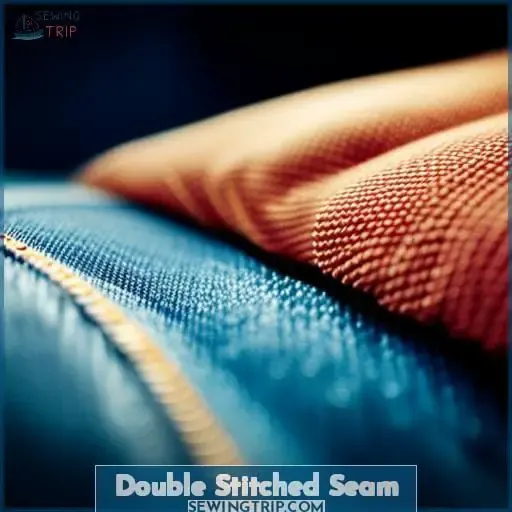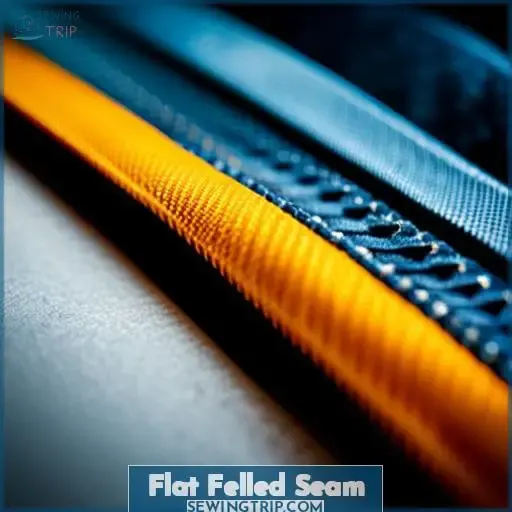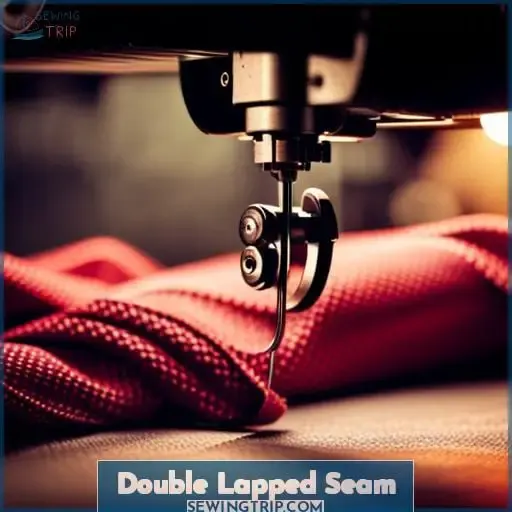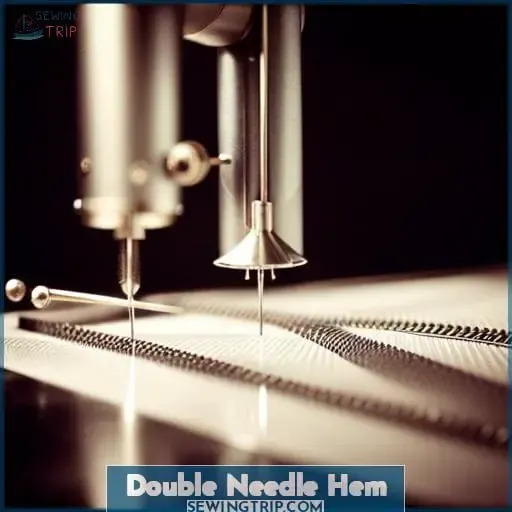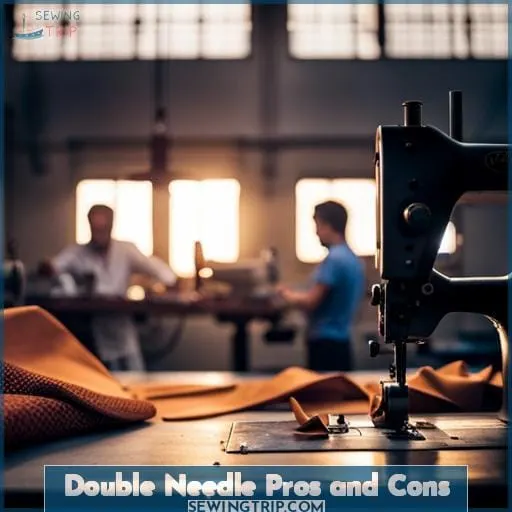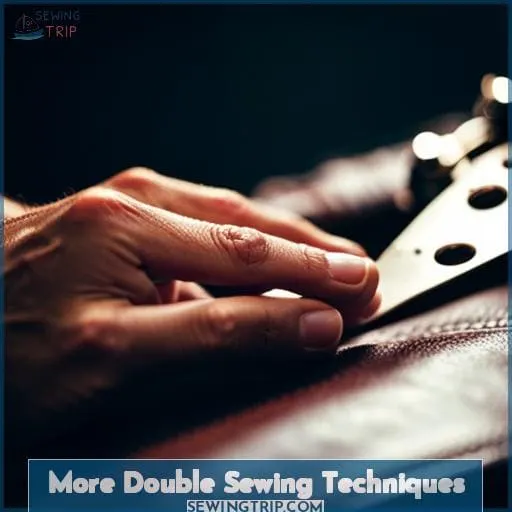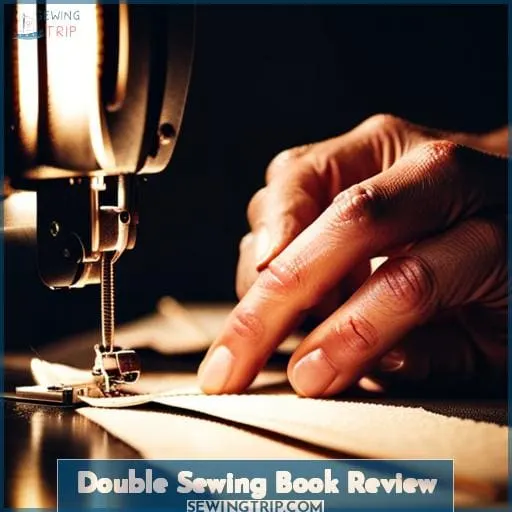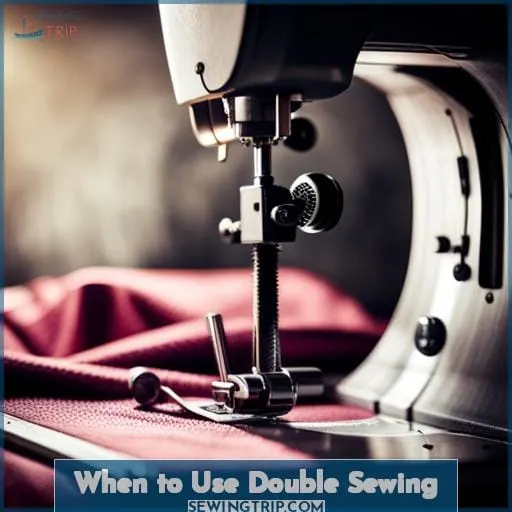This site is supported by our readers. We may earn a commission, at no cost to you, if you purchase through links.
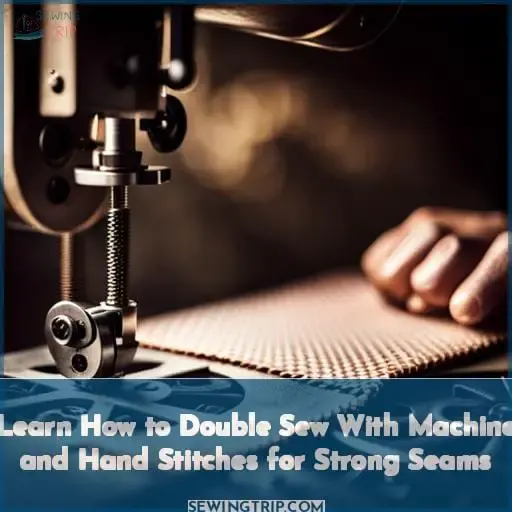
It’s a cinch on the machine or by hand – either way, you’ve got options. The bonus? This basic seam’s got uses galore, from stabilizing stretchy knits to reinforcing jacket pockets.
Give it a go, and don’t be shy with a second row. You want sturdy seams that wow? The double stitched seam’s got you covered, honeys.
Sew on and get creative, ’cause once you start doubling up, you won’t want to stop!
Table Of Contents
Key Takeaways
- Double-sewn seams provide extra strength and durability.
- There are different double stitch techniques, such as flat-felled and lapped seams.
- Use twin needles and test on scraps when sewing by machine to perfect the technique.
- Carefully align fabric layers when hand sewing for a neat finish.
Double Stitched Seam
Double stitching can be done with a machine or by hand. To stitch the seam twice by machine, pass the presser foot over the fabric two times, checking the alignment for each pass. You can also insert a twin needle to create both rows simultaneously. To stitch by hand, first sew a backstitch row, then complete a second neat row of small stitches parallel to the first.
Machine Method
You’ll sew the first seam as usual, then go back and stitch a second seam right next to the first for extra strength. With the machine, align fabrics and sew the initial seam at your preferred width.
Next, run the pieces through again, positioning the presser foot directly adjacent to the first stitching.
This efficient, machine-sewn double seam ensures durability while enhancing the garment’s quality.
Get creative by twin-needling the hems or varying the stitch type. Simply set up the sewing machine for zigzag before inserting a double needle.
The possibilities with double-stitching by machine are really endless!
Hand Stitching Method
Step slowly by hand for full awareness of your seam with each stitch. Choose needles, threads, and stitch styles purposefully. Thicker needles and threads strengthen seams while delicate options reinforce lightly.
Backstitch ends for durability. Try decorative stitches like whip stitching or ladder stitching for visible beauty. After hemming, blanket stitch edges for extra reinforcement. Hand stitching creates connection; treasure the process.
Flat Felled Seam
Rather than start by immediately stitching your seams, first trim one side’s allowance to 1/4 for a flat-felled finish with durability.
- Line up fabrics with wrong sides together, then sew a 5/8 seam.
- Trim one side to 1/4.
- Fold untrimmed side over trimmed, encasing raw edges.
- Fold again, bringing folded edge to center crease.
- Press flat.
- Edge stitch close to inside folded edge.
With practice, flat felling gives garments clean insides. Play with contrasting thread colors on the outside fold for interest. For stability try thicker fabrics, but avoid bulky interfacing. Carefully aligning layers prevents puckering.
Take things slow and check pressing frequently. With patience, flat felled seams produce crisp professional results. Consider flat felling for overalls, jeans, jackets, handbags and more. Master this fundamental technique and unlock unlimited creative potential.
Double Lapped Seam
Next, overlap the fabric edges and fold the seam in an S shape before neatly edge stitching. With double lapped seams, precision’s key. Overlap those fabric edges consistently – aim for 1/2 inch, adjusting as your project requires.
Fold it in an S to tuck in raw edges, then press that seam flat. Edge stitch close to the fold, about 1/8 inch away. Sew a second line 1/2 inch from the first to catch the fold’s backside. This seam lays flat thanks to equal fabric layers.
It’s easy to edge stitch consistently too. Just follow that S shape you’ve pressed. With double lapped seams, you can get away with a smaller seam allowance. They take a few more stitches per seam than other techniques, yet give a clean result.
For garments needing durability and stretch fabrics, it’s ideal. With care, you’ll stitch professional finishes. So overlap precisely, press in that S shape, then edge stitch evenly. You’ll have a flat, strong seam in no time.
Double Needle Hem
Before you start sewing that double needle hem, first prepare your machine by installing the double needle, threading both needles properly, and testing on scrap fabric to ensure the stitching looks good.
Then sew your hem while keeping both fabric layers aligned as you go to achieve a clean, professional finish.
Machine Prep
Take a deep breath as you set up your sewing machine to glide gracefully with the double needle. Install your new twin needles, making sure they are the same size and along the same groove. Thread both needles, being careful not to cross threads. Set your machine to a medium-width, medium-length zigzag stitch to allow for needle clearance.
Test on scrap fabric, tweaking tension as necessary. Now sew your hem, lining up the fabric edge along the needles.
Sewing Steps
Align the fabric under the needle carefully as you sew the hem with double needles. Go slowly, aligning the fabric edges precisely. Stitch from the bottom up, lifting the presser foot to pivot at corners.
Check the tension often, adjusting as needed. Consider clipping curves or notching corners for smooth turning. Practice on scraps first to gain confidence sewing with the twin needles. A community sewing circle provides helpful tips and tricks for success.
With patience and precision, you’ll have a professional double needle hem to showcase your skills.
Double Needle Pros and Cons
You’ve mastered the double needle hem, so let’s explore the pros and cons of double needles for stitching. This useful tool adds flexibility and durability to projects, preventing popped threads when stretching the hemmed edge.
First, make sure your sewing machine can zig zag – that’s crucial for using a double needle. Also, reserve double needles for hems rather than seams, as the spacing affects seam finishing.
| Needle Type | Flexible Hem | Even Feed | Works in All Machines |
|---|---|---|---|
| Single | No | Yes | Yes |
| Double | Yes | No | No |
Overall, double needles professionally finish stretchy hems. But you’ll need to prepare your machine and materials for the best results. Focus this specialty needle on its ideal purpose – hemming – and you’ll love the quality outcome.
More Double Sewing Techniques
Check out that cool book for more creative double sewing ideas you’ll love stitching up! Here are 4 fun double sewing techniques to try:
- Sew a double layer skirt – Double the flair! Use a lightweight inner layer and flowy outer layer.
- Add decorative double piping – Frame seams and edges with a bold pop of color.
- Finish your hems with a twin needle – Reinforce stretchy hems for a clean look.
- Overcast edges with a serger before hemming – Prevent fraying with a professional touch.
Experiment with creative ways to use double stitching in your next project. Connect with other sewing enthusiasts to get inspired and share your makes. With a bit of practice, you’ll be a pro at stitching doubled seams, hems and more in no time.
Double Sewing Book Review
Look beyond the craft and embrace the art of sewing by thumbing through this double-stitched book of stylish projects. Immerse yourself in a creative sewing journey guided by the talented Sew Can She bloggers.
Within the 128 pages, unlock full-size patterns, step-by-step instructions, and an array of achievable projects organized by month. Though directions lean vague in spots, the book arms beginners with approachable, fun sews and more advanced sewers with fresh inspiration.
Let go of perfection and fearlessly dive into the satisfying process of creating something beautiful with your own two hands. With this book as your guide, step confidently into the world of sewing and experience the freedom that comes from belonging to a community filled with understanding.
| Project | Skills Developed | Difficulty |
|---|---|---|
| Floral Tablerunner | Basic Sewing Skills | Beginner |
| Reversible Apron | Pockets, Ties | Beginner |
| Ruffled Skirt | Gathering, Hemming | Intermediate |
| Faux Fur Vest | Lining, Notch Collar | Advanced |
When to Use Double Sewing
When sewing lightweight, delicate fabrics that need durability, don’t reject doubling your stitching.
- Sheer fabrics like chiffon or voile that require reinforcement against tearing. A double stitched seam offers invisible strength.
- Silky fabrics prone to fraying and unraveling demand enclosed raw edges. Doubling the stitching neatly finishes edges.
- Stretch knits that get pulled and stressed beg for extra seam durability. Double stitching prevents seams from popping under pressure.
Unlike a plain seam’s single pass, the double stitched seam has two rows of stitching on the right side. This grants lightweight and delicate fabrics strength to withstand daily wearing and washing without compromising the drape and feel.
Explore creative color combinations by using contrasting thread colors for each pass. With some thoughtful technique adjustments, even heavy fabrics can benefit from the clean look of a double stitched seam.
Conclusion
Add strength and longevity to your garments by learning to double sew. Spend just 5 minutes practicing hand stitches or machine methods like the flat-felled seam, and open yourself up to a world of crisp hems, durable seams, and professional finishes.
With over a dozen techniques for reinforcing fabric using two lines of thread, double sewing prevents popped seams so you can wear your homemade clothes with confidence. Approach double sewing as an investment in quality construction, and discover the joys of garments that truly withstand the test of time.

